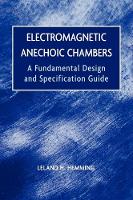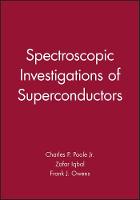Electromagnetic Anechoic Chambers
 -15%
portes grátis
-15%
portes grátis
Electromagnetic Anechoic Chambers
A Fundamental Design and Specification Guide
Hemming, Leland H.
John Wiley & Sons Inc
07/2002
248
Dura
Inglês
9780471208105
15 a 20 dias
564
1 Introduction.
1.1 The Text Organization.
References.
2 Measurement Principles Pertaining to Anechoic Chamber Design.
2.1 Introduction.
2.2 Measurement of Electromagnetic Fields.
2.2.1 Introduction.
2.2.2 Antennas.
2.2.3 Radiated Emissions.
2.2.4 Radiated Susceptibility.
2.2.5 Military Electromagnetic Compatibility.
2.2.6 Antenna System Isolation.
2.2.7 Radar Cross Section.
2.3 Free-Space Test Requirements.
2.3.1 Introduction.
2.3.2 Phase.
2.3.3 Amplitude.
2.3.4 Polarization.
2.3.5 The Friis Transmission Formula.
2.4 Supporting Measurement Concepts.
2.4.1 Introduction.
2.4.2 Coordinate Systems and Device Positioners.
2.4.3 Decibels.
2.4.4 Effects of Reflected Energy.
2.4.5 Effects of Antenna Coupling.
2.5 Outdoor Measurement Facilities.
2.5.1 Introduction.
2.5.2 Electromagnetic Design Considerations and Criteria.
2.5.3 Elevated Outdoor Antenna Range.
2.5.4 Ground Reflection Antenna Range.
2.5.5 Open-Area Test Sites (OATS).
References.
3 Electromagnetic Absorbing Materials.
3.1 Introduction.
3.2 Microwave Absorbing Materials.
3.2.1 Pyramidal Absorber.
3.2.2 Wedge Absorber.
3.2.3 Convoluted Microwave Absorber.
3.2.4 Multilayer Dielectric Absorber.
3.2.5 Hybrid Dielectric Absorber.
3.2.6 Walkway Absorber.
3.3 Low-Frequency Absorbing Material.
3.3.1 Introduction.
3.3.2 Ferrite Absorbers.
3.3.3 Hybrid Absorbers.
3.4 Absorber Modeling.
3.5 Absorber Testing.
References.
4 The Chamber Enclosure.
4.1 Introduction.
4.2 Electromagnetic Interference.
4.3 Controlling the Environment.
4.4 Electromagnetic Shielding.
4.4.1 Introduction.
4.4.2 The Welded Shield.
4.4.3 The Clamped Seam or Prefabricated Shield.
4.4.4 The Single-Shield Systems.
4.5 Penetrations.
4.6 Performance Verification.
4.7 Shielded Enclosure Grounding.
4.8 Fire Protection.
References.
5 Anechoic Chamber Design Techniques.
5.1 Introduction.
5.2 Practical Design Procedures.
5.2.1 Introduction.
5.2.2 Quick Estimate of Chamber Performance.
5.2.3 Detailed Ray-Tracing Design Procedure.
5.3 Computer Modeling.
5.3.1 Introduction.
5.3.2 Ray Tracing.
5.3.3 Finite-Difference Time-Domain Model.
5.4 Other Techniques.
5.5 Antennas Used In Anechoic Chambers.
5.5.1 Introduction.
5.5.2 Rectangular Chamber Antennas.
5.5.3 Antennas for Tapered Chambers.
5.5.4 EMI Chambers.
References.
6 The Rectangular Chamber.
6.1 Introduction.
6.2 Antenna Testing.
6.2.1 Introduction.
6.2.2 Design Considerations.
6.2.3 Design Example.
6.2.4 Acceptance Test Procedures.
6.3 Radar Cross-Section Testing.
6.3.1 Design Considerations.
6.3.2 Design Example.
6.3.3 Acceptance Test Procedures.
6.4 Near-Field Testing.
6.4.1 Introduction.
6.4.2 Chamber Design Considerations.
6.4.3 Design Example.
6.4.4 Acceptance Test Procedure.
6.5 Electromagnetic Compatibility Testing.
6.5.1 Introduction.
6.5.2 Chamber Design Considerations.
6.5.3 Design Examples.
6.5.4 Acceptance Test Procedures.
6.6 Immunity Testing.
6.6.1 Introduction.
6.6.2 Mode-Stirred Test Facility.
6.7 EM System Compatibility Testing.
6.7.1 Design Considerations.
6.7.2 Acceptance Testing.
References.
7 The Compact Range Chamber.
7.1 Introduction.
7.2 Antenna Testing.
7.2.1 Prime Focus Compact Range.
7.2.2 Dual Reflector Compact Range.
7.2.3 Shaped Reflector Compact Range.
7.2.4 Compact Antenna Range Absorber Layout.
7.2.5 Acceptance Testing of the Compact Antenna Anechoic Chamber.
7.3 Compact RCS Ranges.
7.3.1 Introduction.
7.3.2 Design Example.
7.3.3 Acceptance Testing.
References.
8 Incorporating Geometry in Anechoic Chamber Design.
8.1 Introduction.
8.2 The Tapered Chamber.
8.2.1 Introduction.
8.2.2 Antenna Testing.
8.2.3 Radar Cross-Section Measurements.
8.3 The Double Horn Chamber.
8.3.1 Introduction.
8.3.2 Antenna Testing.
8.3.3 Emissions and Immunity Testing.
8.4 The Missile Hardware-in-the-Loop Chamber.
8.4.1 Introduction.
8.4.2 Design Considerations.
8.4.3 Design Example.
8.4.4 Acceptance Test Procedures.
8.5 Consolidated Facilities.
8.5.1 Introduction.
8.5.2 Design Considerations.
8.5.3 Design Examples.
8.5.4 Acceptance Test Procedures.
8.6 The TEM Cell.
8.6.1 Introduction.
8.6.2 TEM Principles of Operation.
8.6.3 Typical Performance.
References.
9 Test Procedures.
9.1 Introduction.
9.2 Absorber Testing.
9.2.1 Introduction.
9.2.2 Testing of Microwave Absorber.
9.2.3 Low-Frequency Testing.
9.2.4 Compact Range Reflector Testing.
9.2.5 Fire-Retardant Testing.
9.3 Microwave Anechoic Chamber Test Procedures.
9.3.1 Introduction.
9.3.2 Free-Space VSWR Method.
9.3.3 Pattern Comparison Method.
9.3.4 X-Y Scanner Method.
9.3.5 RCS Chamber Evaluation.
9.4 EMC Chamber Acceptance Test Procedures.
9.4.1 Introduction.
9.4.2 Volumetric Site Attenuation.
9.4.3 Field Uniformity.
9.5 Shielding Effectiveness.
References.
10 Examples of Indoor Electromagnetic Test Facilities.
10.1 Introduction.
10.2 Antenna Testing.
10.2.1 Introduction.
10.2.2 Rectangular Test Chamber.
10.2.3 Tapered Anechoic Chamber.
10.2.4 Compact Range Test Chamber.
10.2.5 Near-Field Test Chamber.
10.3 Radar Cross-Section Testing.
10.3.1 Introduction.
10.3.2 Compact Range Radar Cross-Section Facilities.
10.4 EMC Test Chambers.
10.4.1 Introduction.
10.4.2 Emission Test Chambers.
10.5 Electromagnetic System Compatibility Testing.
10.5.1 Introduction.
10.5.2 Aircraft Systems.
10.5.3 Spacecraft Test Facilities.
References.
Appendix A: Procedure for Determining the Area of Specular Absorber Treatment.
A.1 Introduction.
A.2 Fresnel Zone Analysis.
Appendix B :Test Region Amplitude Taper.
B.1 Introduction.
B.2 Antenna Data.
Appendix C: Design/Specification Checklists.
C.1 Introduction.
C.2 The Rectangular Chamber.
C.2.1 Introduction.
C.2.2 Antenna Testing.
C.2.3 RCS Testing.
C.2.4 Near-Field Testing.
C.2.5 EMI Testing.
C.2.6 Isolation Testing.
C.2.7 Impedance Testing.
C.3 Compact Range.
C.3.1 Introduction.
C.3.2 Antenna/Radome Testing.
C.3.3 RCS Testing.
C.4 Shaped Chambers.
C.4.1 Introduction
C.4.2 Tapered Chamber.
C.4.3 Double Horn Chamber.
C.4.4 Hardware-in-the-Loop Testing.
C.5 Shielding Design Checklist.
C.5.1 Introduction.
C.5.2 Checklist for Prefabricated Shielding.
C.5.3 Checklist for Welded Enclosures.
C.5.4 Checklist for Architectural Shielding.
C.5.5 Conventional Construction.
C.5.6 Fire Protection.
References.
Glossary.
Selected Bibliography.
Index.
About the Author.
1 Introduction.
1.1 The Text Organization.
References.
2 Measurement Principles Pertaining to Anechoic Chamber Design.
2.1 Introduction.
2.2 Measurement of Electromagnetic Fields.
2.2.1 Introduction.
2.2.2 Antennas.
2.2.3 Radiated Emissions.
2.2.4 Radiated Susceptibility.
2.2.5 Military Electromagnetic Compatibility.
2.2.6 Antenna System Isolation.
2.2.7 Radar Cross Section.
2.3 Free-Space Test Requirements.
2.3.1 Introduction.
2.3.2 Phase.
2.3.3 Amplitude.
2.3.4 Polarization.
2.3.5 The Friis Transmission Formula.
2.4 Supporting Measurement Concepts.
2.4.1 Introduction.
2.4.2 Coordinate Systems and Device Positioners.
2.4.3 Decibels.
2.4.4 Effects of Reflected Energy.
2.4.5 Effects of Antenna Coupling.
2.5 Outdoor Measurement Facilities.
2.5.1 Introduction.
2.5.2 Electromagnetic Design Considerations and Criteria.
2.5.3 Elevated Outdoor Antenna Range.
2.5.4 Ground Reflection Antenna Range.
2.5.5 Open-Area Test Sites (OATS).
References.
3 Electromagnetic Absorbing Materials.
3.1 Introduction.
3.2 Microwave Absorbing Materials.
3.2.1 Pyramidal Absorber.
3.2.2 Wedge Absorber.
3.2.3 Convoluted Microwave Absorber.
3.2.4 Multilayer Dielectric Absorber.
3.2.5 Hybrid Dielectric Absorber.
3.2.6 Walkway Absorber.
3.3 Low-Frequency Absorbing Material.
3.3.1 Introduction.
3.3.2 Ferrite Absorbers.
3.3.3 Hybrid Absorbers.
3.4 Absorber Modeling.
3.5 Absorber Testing.
References.
4 The Chamber Enclosure.
4.1 Introduction.
4.2 Electromagnetic Interference.
4.3 Controlling the Environment.
4.4 Electromagnetic Shielding.
4.4.1 Introduction.
4.4.2 The Welded Shield.
4.4.3 The Clamped Seam or Prefabricated Shield.
4.4.4 The Single-Shield Systems.
4.5 Penetrations.
4.6 Performance Verification.
4.7 Shielded Enclosure Grounding.
4.8 Fire Protection.
References.
5 Anechoic Chamber Design Techniques.
5.1 Introduction.
5.2 Practical Design Procedures.
5.2.1 Introduction.
5.2.2 Quick Estimate of Chamber Performance.
5.2.3 Detailed Ray-Tracing Design Procedure.
5.3 Computer Modeling.
5.3.1 Introduction.
5.3.2 Ray Tracing.
5.3.3 Finite-Difference Time-Domain Model.
5.4 Other Techniques.
5.5 Antennas Used In Anechoic Chambers.
5.5.1 Introduction.
5.5.2 Rectangular Chamber Antennas.
5.5.3 Antennas for Tapered Chambers.
5.5.4 EMI Chambers.
References.
6 The Rectangular Chamber.
6.1 Introduction.
6.2 Antenna Testing.
6.2.1 Introduction.
6.2.2 Design Considerations.
6.2.3 Design Example.
6.2.4 Acceptance Test Procedures.
6.3 Radar Cross-Section Testing.
6.3.1 Design Considerations.
6.3.2 Design Example.
6.3.3 Acceptance Test Procedures.
6.4 Near-Field Testing.
6.4.1 Introduction.
6.4.2 Chamber Design Considerations.
6.4.3 Design Example.
6.4.4 Acceptance Test Procedure.
6.5 Electromagnetic Compatibility Testing.
6.5.1 Introduction.
6.5.2 Chamber Design Considerations.
6.5.3 Design Examples.
6.5.4 Acceptance Test Procedures.
6.6 Immunity Testing.
6.6.1 Introduction.
6.6.2 Mode-Stirred Test Facility.
6.7 EM System Compatibility Testing.
6.7.1 Design Considerations.
6.7.2 Acceptance Testing.
References.
7 The Compact Range Chamber.
7.1 Introduction.
7.2 Antenna Testing.
7.2.1 Prime Focus Compact Range.
7.2.2 Dual Reflector Compact Range.
7.2.3 Shaped Reflector Compact Range.
7.2.4 Compact Antenna Range Absorber Layout.
7.2.5 Acceptance Testing of the Compact Antenna Anechoic Chamber.
7.3 Compact RCS Ranges.
7.3.1 Introduction.
7.3.2 Design Example.
7.3.3 Acceptance Testing.
References.
8 Incorporating Geometry in Anechoic Chamber Design.
8.1 Introduction.
8.2 The Tapered Chamber.
8.2.1 Introduction.
8.2.2 Antenna Testing.
8.2.3 Radar Cross-Section Measurements.
8.3 The Double Horn Chamber.
8.3.1 Introduction.
8.3.2 Antenna Testing.
8.3.3 Emissions and Immunity Testing.
8.4 The Missile Hardware-in-the-Loop Chamber.
8.4.1 Introduction.
8.4.2 Design Considerations.
8.4.3 Design Example.
8.4.4 Acceptance Test Procedures.
8.5 Consolidated Facilities.
8.5.1 Introduction.
8.5.2 Design Considerations.
8.5.3 Design Examples.
8.5.4 Acceptance Test Procedures.
8.6 The TEM Cell.
8.6.1 Introduction.
8.6.2 TEM Principles of Operation.
8.6.3 Typical Performance.
References.
9 Test Procedures.
9.1 Introduction.
9.2 Absorber Testing.
9.2.1 Introduction.
9.2.2 Testing of Microwave Absorber.
9.2.3 Low-Frequency Testing.
9.2.4 Compact Range Reflector Testing.
9.2.5 Fire-Retardant Testing.
9.3 Microwave Anechoic Chamber Test Procedures.
9.3.1 Introduction.
9.3.2 Free-Space VSWR Method.
9.3.3 Pattern Comparison Method.
9.3.4 X-Y Scanner Method.
9.3.5 RCS Chamber Evaluation.
9.4 EMC Chamber Acceptance Test Procedures.
9.4.1 Introduction.
9.4.2 Volumetric Site Attenuation.
9.4.3 Field Uniformity.
9.5 Shielding Effectiveness.
References.
10 Examples of Indoor Electromagnetic Test Facilities.
10.1 Introduction.
10.2 Antenna Testing.
10.2.1 Introduction.
10.2.2 Rectangular Test Chamber.
10.2.3 Tapered Anechoic Chamber.
10.2.4 Compact Range Test Chamber.
10.2.5 Near-Field Test Chamber.
10.3 Radar Cross-Section Testing.
10.3.1 Introduction.
10.3.2 Compact Range Radar Cross-Section Facilities.
10.4 EMC Test Chambers.
10.4.1 Introduction.
10.4.2 Emission Test Chambers.
10.5 Electromagnetic System Compatibility Testing.
10.5.1 Introduction.
10.5.2 Aircraft Systems.
10.5.3 Spacecraft Test Facilities.
References.
Appendix A: Procedure for Determining the Area of Specular Absorber Treatment.
A.1 Introduction.
A.2 Fresnel Zone Analysis.
Appendix B :Test Region Amplitude Taper.
B.1 Introduction.
B.2 Antenna Data.
Appendix C: Design/Specification Checklists.
C.1 Introduction.
C.2 The Rectangular Chamber.
C.2.1 Introduction.
C.2.2 Antenna Testing.
C.2.3 RCS Testing.
C.2.4 Near-Field Testing.
C.2.5 EMI Testing.
C.2.6 Isolation Testing.
C.2.7 Impedance Testing.
C.3 Compact Range.
C.3.1 Introduction.
C.3.2 Antenna/Radome Testing.
C.3.3 RCS Testing.
C.4 Shaped Chambers.
C.4.1 Introduction
C.4.2 Tapered Chamber.
C.4.3 Double Horn Chamber.
C.4.4 Hardware-in-the-Loop Testing.
C.5 Shielding Design Checklist.
C.5.1 Introduction.
C.5.2 Checklist for Prefabricated Shielding.
C.5.3 Checklist for Welded Enclosures.
C.5.4 Checklist for Architectural Shielding.
C.5.5 Conventional Construction.
C.5.6 Fire Protection.
References.
Glossary.
Selected Bibliography.
Index.
About the Author.















